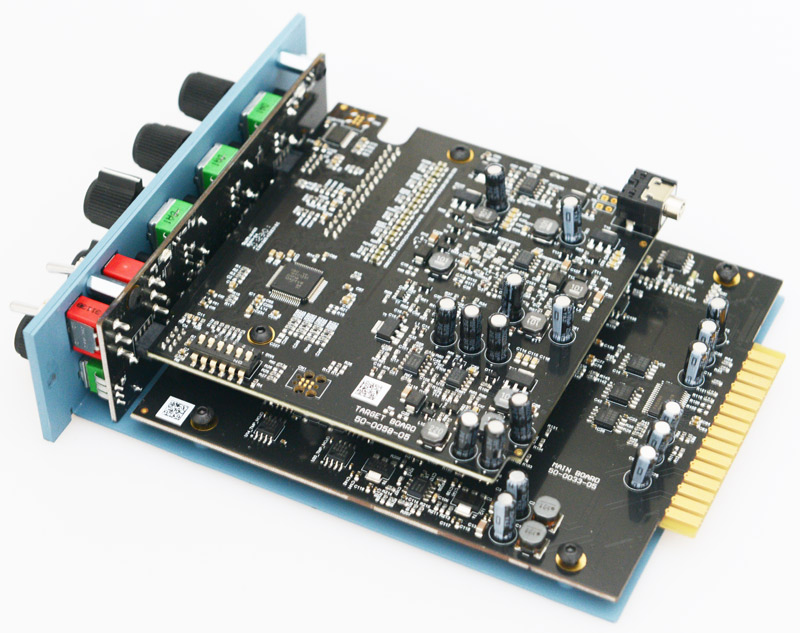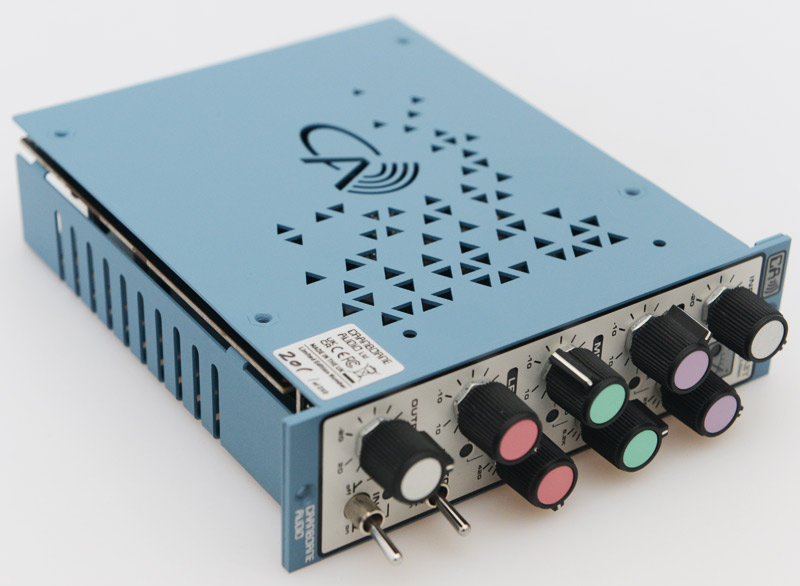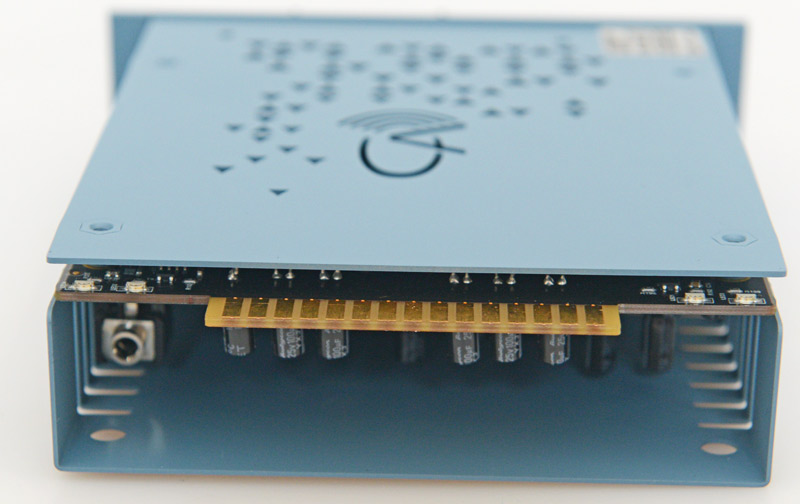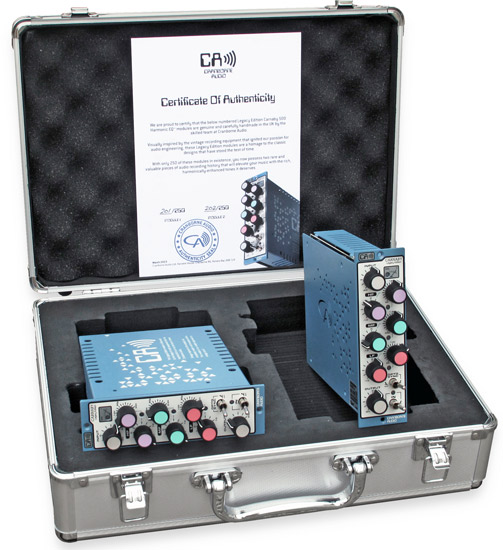Cranborne Audio Carnaby
API 500 Module Three-band Harmonic Equalizer
Author: Matthias Fuchs | Photos: Peter Kaminski, Matthias Fuchs (2)
Harmonic Equalizer – excuse me? At first glance, it looks almost like an ordinary three-band EQ promise; however, upon closer inspection – and according to the manufacturer – this module is a real innovation boost in analog audio. But first things first: Cranborne Audio, a fairly young London-based manufacturer, has already caused a few pleasant surprises in the audio market in the five years since its founding. The stated goal of the four Brits with a background in the legendary console manufacturer Soundcraft is not only to develop tools for maximum signal processing quality, but also to supplement well-known concepts with innovative features – a keyword being the “Mojo” button of their celebrated Camden 500 preamp and 500 rack enclosure with comprehensive DAW connectivity. And now a Harmonic-EQ...
Concept and technology
In the late 1970s, a device with the intriguing name “Aural Exciter” caused a sensation. At the time, it was hyped as a mysterious and incredibly expensive secret weapon for improving and refreshing the sound of tape recordings. The principle was quite simple: a certain amount of the input signal was diverted and enriched with harmonic overtones by means of subtle distortion. This signal was mixed with the original at a low level and, if necessary, with a modified phase. Voilá – the result appeared more present, more assertive, and subjectively louder, although there was no significant increase in volume. The principle polarized the audio world at the time, meeting with both ardent admirers and strict rejection.
Today, similar devices still exist; however, of course, in the 24-bit/196-kHz era, a lack of treble is no longer a major issue. Accordingly, overtone generators can today call themselves “saturators” and “pollute” overly clean 24/196 sounds with additional overtones. There are numerous tools that contain or emulate analog circuits at the limit for this purpose. They are available both as hardware and as plug-ins. The designs mainly differ in the range of different “saturation processes” or their emulation and the type of “admixture” – whether it is applied to the entire signal or only to certain frequency ranges.
The analog Vertigo Mix Satellite and the Wavesfactory Spectre plug-in are mentioned here as examples. There is no doubt that this principle still has its appeal because it offers some interesting possibilities: it dynamically adds a component that was not previously present in the signal and can produce significant sound changes with almost no increase in the signal level. The Cranborne developers probably followed this line of thought when designing their Harmonic EQ – a three-band equalizer extended by a variable overtone enrichment.
The manufacturer (understandably) remains silent about the exact technical implementation. A look inside the 500 series cassette reveals plenty of top-notch analog technology, including a large number of high-quality op-amps and several voltage dividers. The EQ circuits use gyrators, similar to those used in some classics, to replicate coils in a space-saving way. Furthermore, the Harmonic-EQ also has a partially digital interior for the very innovative Link function. But more about that later.
Appearance
The Harmonic-EQ cassette has a solid front panel and is equipped with neatly screwed controls. The eight potentiometers are slightly gridded with 40 steps and feel excellent. The two toggle switches also give no cause for complaint. The housing itself consists of thin sheet steel and is decorated with numerous openings, cutouts, and breakthroughs.
The cover of the Legacy Edition can be removed by loosening four screws – and reassembled with a little fiddling. Overall, the construction makes a solid impression, and the controls are exemplary but very densely packed. Inside the unit, there is a DIP switch strip that can be used to set some “utility” settings, including how the LEDs and bypass switch work.
Carnaby 500 versus Legacy Edition
The standard version of the Carnaby 500 features a black front panel and black knobs. The labeling provides several colorful highlights.

For the limited edition of 250 units of the Legacy Edition, Cranborne Audio has come up with an alternative color scheme that, with its pastel matte colors, perfectly matched the taste of the tester – a very successful blend of style and technology look that has a lot going for it compared to the black color scheme of the standard version. The technical performance features are the same. The only differences are in the design and scope of delivery. For example, the standard version does not have a metal cover on the top side of the circuit board.
The Legacy Edition is only available in pairs and comes in a stylish case that is unfortunately made almost entirely of plastic. A certificate and brief operating instructions complete the scope of delivery of the Legacy Edition.
Functions
What exactly does the Cranborne Audio Carnaby do? Keeping it short, the device boosts and cuts certain frequency ranges in the same way as a “normal” EQ does. In addition, Carnaby can enrich these frequency ranges with overtones – in other words, if you will, the “exciter” or “saturator nature” of the Carnaby.
The input and output knobs are used for gain staging and offer 20 dB of level increase or decrease, respectively. An LED monitors the output level. The cutoff or center frequencies of the three bands can now be selected using the knobs arranged in pairs, and their levels can be adjusted by +/- 10 dB in 0.5 dB steps. Turning one of the level controls to the right boosts the fundamental and also generates harmonics above the selected frequency. Because the overtone enrichment depends on the level of the input signal, this process exhibits a perceivable dynamic. Turning the control to the left lowers the fundamental and thus also changes the level ratio between the fundamental and harmonics.
Several modules can be linked in sync mode. All knobs are then controlled by one module. The manufacturer has come up with a very interesting technical solution for this: the data is passed between neighboring modules by opto-electronic means, i.e., by means of an LED and a photodiode. If you are running two modules horizontally next to each other – as in our test setup – the “Optosync” can be replaced by a cable. A bypass switch completes the functionality. The bypass can be placed either before or after the output stage via an internal DIP switch.
Practice

The concept of the Cranborne Audio Carnaby undoubtedly arouses curiosity. During the test, it quickly became clear that the effect of the device is initially compared involuntarily with that of an ordinary EQ. In fact, as expected, there are numerous parallels in this case. Basically, the Carnaby emphasizes or attenuates certain frequency ranges, thus producing results very similar to those of an EQ – signals become more present, sharper, rounder, flatter, etc.
However, the more you “listen” to the Carnaby, the more obvious the differences to a traditional EQ become. The unit works in a way that is anything but linear – in contrast to an EQ, it reacts to the dynamics of the input signal to a high degree. In particular, with the moderate settings, the parameters appear to interact in a clearly perceptible manner and deliver comparatively unpredictable results. With heavy processing, on the other hand, the sound changes can be more precisely controlled.
Different input signals can elicit highly diverse reactions from the unit and help to develop an interesting life of its own. A certain compression effect is always accompanied by an increase in level. This allows the Carnaby to make signals – such as vocals – seem to appear “closer” or wider. Drums sometimes appear denser and more dynamic. A significant reduction in the low-frequency band can “open” a signal and make it appear more present or spatial. However, similar results can be achieved by boosting or enriching mid- or high-frequencies.
In principle, a fine and very careful adjustment is necessary to achieve optimal results. The stereo link function is a welcome help in this regard. The only drawback: the digitally scanned knobs produce slight but perceptible zipper noise. Apart from that, the signal quality is impeccable in every respect.
Conclusion
The price of the normal Carnaby 500 is around 700 euros. The limited-edition Legacy Edition in a double set with a case costs around 2,000 euros, but due to the limited quantity, it is likely to be no longer available by the time this article is published. However, as already mentioned, the only differences between the normal and the limited edition are the design and scope of delivery.
The Cranborne Audio Carnaby is a sound processing device that is as special as it is exciting. The Carnaby is not designed for simple and precise correction of sound images. Nor is it a classic “beautifier” in the sense of a high-quality vintage EQ. The Carnaby provides signals with a very interesting character across the board, and also fundamentally influences the dynamics. It invites experimentation and surprises with very different reactions to a wide variety of program material on the way to optimal parameter settings.
Processing stems or subgroups is probably the Carnaby's favorite pastime. But individual signals also offer a wide range of interesting sound manipulations, from subtle to striking. If you embrace the peculiarities of the device, you can achieve great results with the Carnaby that are not possible or only partially achievable with other devices. Thus, the Cranborne Audio Carnaby Harmonic EQ is a welcome creative tool and truly an enrichment for the recording and mix studio. The Legacy Edition is also a pleasure to look at.
 How to resolve AdBlock issue?
How to resolve AdBlock issue? 




